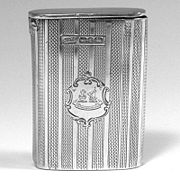
Vesta case
Encyclopedia

So called after the name of one of the early makers (which was taken from the goddess Vesta
Vestal Virgin
In ancient Roman religion, the Vestals or Vestal Virgins , were priestesses of Vesta, goddess of the hearth. The College of the Vestals and its well-being was regarded as fundamental to the continuance and security of Rome, as embodied by their cultivation of the sacred fire that could not be...
, a Roman deity of fire and the hearth), they came into use around the 1830s and were produced extensively between 1890 and 1920. During this period, almost everyone carried strike anywhere matches, so they could light stoves, lanterns and other devices. Early matches were unreliable and prone to ignite from rubbing on one another or spontaneously. Accordingly, most people carried a match safe to house their matches. Wealthy people had match safes made of gold or silver, while common folk had ones made of tin or brass.
Significant American manufacturers of match safes include Wm. B. Kerr, Gorham, Unger Brothers, Battin, Blackington, Whiting, George Scheibler and Shreve & Co.
The different patterns and types must had run into many thousands. As well as plain and decorated square, oblong and round cases, a myriad of novelty shapes have been recorded; brass pigs with hinged heads were popular, as were vesta cases in the form of Mr Punch, skulls, musical instruments, boots and shoes, bottles, ladies' legs and so on.
They were also made in every conceivable material including pressed brass, pressed tin, gunmetal, nickel silver, ivory, wood of varying types, early plastics like tortoiseshell and vulcanite, and ceramics. Although the majority were made of these inexpensive materials, some were made of precious metal
Metal
A metal , is an element, compound, or alloy that is a good conductor of both electricity and heat. Metals are usually malleable and shiny, that is they reflect most of incident light...
s or enameled
Vitreous enamel
Vitreous enamel, also porcelain enamel in U.S. English, is a material made by fusing powdered glass to a substrate by firing, usually between 750 and 850 °C...
. These precious metal cases typically had a gold wash interior to prevent corrosion by the chemically active match heads.
A distinguishing characteristic of match safes is that they have a ribbed surface, usually on the bottom, for lighting the matches. Some match safes incorporated a cigar cutter or a small knife blade as well. Often made to be carried in the pocket, some were small enough to be suspended from the Albert chain. Others were made to be left in a handy position in the home, such as the kitchen or close to a fire place.
Vesta cases are still to be found in a vast array of shapes, sizes and materials, and many are extremely attractive.
Occasionally a vesta case was made to double as a go-to-bed matchbox
Go-to-bed matchbox
Go-to-bed or getting-into-bed matchboxes were a variety of match storage box popular in the mid-to-late 19th century. Relatively small, about 6 cm high, they were frequently made of metal of some kind, though sometimes of wood or ivory....
.

